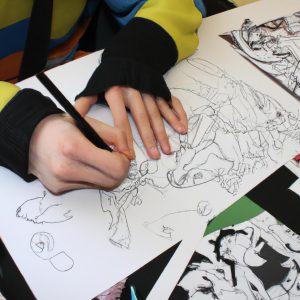Manga in Arts and Comics: An Informative Overview

The world of manga, a popular form of Japanese comic books and graphic novels, has captivated readers worldwide with its unique artistic style and captivating storytelling. This article aims to provide an informative overview of manga in arts and comics, exploring its historical origins, artistic techniques, cultural impact, and global reach. To illustrate the significance of manga as an art form, let us consider the case study of “One Piece,” a highly acclaimed manga series created by Eiichiro Oda that has sold over 460 million copies globally.
Manga’s roots can be traced back to the late 19th century when it emerged as a distinct genre in Japan. Combining traditional Japanese visual aesthetics with influences from Western art forms such as American comics and European cartoons, manga developed into a distinctive style characterized by large expressive eyes, exaggerated gestures, and dynamic panel layouts. The intricate linework and meticulous attention to detail make each page a work of art in itself, capturing the essence of the story while engaging readers through visual storytelling elements like action lines and sound effects. As demonstrated by the immense popularity of “One Piece” across different cultures and age groups, manga’s universal appeal lies not only in its visually stunning artwork but also in its ability to convey complex narratives that resonate with readers on a deeply emotional level.
One of the key aspects that sets manga apart from other comic book formats is its focus on long-form storytelling. Many manga series, including “One Piece,” span hundreds or even thousands of chapters, allowing for intricate world-building and character development. This immersive storytelling approach allows readers to become deeply invested in the lives and adventures of the characters, forming strong emotional connections that can last for years.
Manga’s impact on popular culture extends far beyond Japan’s borders. Over the past few decades, manga has gained a massive following worldwide, with translations available in numerous languages. Its influence can be seen in various forms of media, such as anime adaptations, video games, merchandise, and cosplay. The unique blend of Japanese cultural elements and universal themes explored in manga has helped bridge cultural gaps and foster understanding among diverse audiences.
The success of “One Piece” serves as a testament to the global reach and impact of manga. The series follows the adventures of Monkey D. Luffy and his crew as they search for the ultimate treasure known as One Piece. It explores themes of friendship, loyalty, dreams, and personal growth while tackling complex issues like government corruption and social inequality.
Through its captivating storyline and visually stunning artwork, “One Piece” has garnered a dedicated fanbase around the world. The series’ popularity has led to numerous adaptations in different media forms, including an anime television series spanning over 1000 episodes, movies, video games, merchandise lines, and even theme park attractions.
In conclusion, manga is more than just a form of entertainment; it is an art form that combines visual storytelling with complex narratives to captivate readers across cultures. Through works like “One Piece,” manga continues to push boundaries and inspire artists globally while leaving a lasting impact on popular culture.
Manga: Definition and Origins
Imagine a young teenager, engrossed in a captivating comic book with distinct art style and intricate storytelling. This is the world of manga, a popular form of Japanese comic books and graphic novels that has gained immense global recognition. Derived from the Japanese words “man” (meaning whimsical or playful) and “ga” (meaning picture), manga encompasses a wide range of genres, including fantasy, romance, action, and science fiction.
Manga dates back to the late 19th century when it emerged as an integral part of Japanese culture. It was Osamu Tezuka, often referred to as the “Godfather of Manga,” who revolutionized the medium with his iconic works such as “Astro Boy” and “Black Jack.” Tezuka’s influence extended beyond Japan’s borders, inspiring countless artists worldwide to embrace this distinctive artistic style characterized by its large eyes, exaggerated facial expressions, and dynamic page layouts.
To understand the appeal of manga on a deeper level, consider these emotional responses evoked through bullet points:
- Escapism: Manga offers readers an immersive experience into fantastical worlds where they can momentarily escape from reality.
- Empathy: Characters within manga are often relatable individuals with their own struggles and triumphs, allowing readers to connect emotionally.
- Visual Delight: The vibrant illustrations in manga captivate readers’ attention while enhancing their overall reading experience.
- Cultural Exploration: Through diverse narratives infused with uniquely Japanese cultural elements, manga provides readers with glimpses into different perspectives.
| Emotionally-Charged | Thought-Provoking | Visually Engaging | Culturally Rich |
|---|---|---|---|
| Escapism | Empathy | Visual Delight | Cultural Exploration |
In exploring the characteristics of manga art style in subsequent sections, we will delve further into what makes manga so distinct and beloved by fans worldwide. Through its origins, influences, and artistic elements, manga has evolved into an art form that continues to captivate audiences across borders and generations alike.
Characteristics of Manga Art Style
Now, let us delve further into the world of manga art by exploring its distinctive characteristics. Manga is renowned for its unique visual style, which sets it apart from other forms of comic art. The art style is characterized by exaggerated facial expressions, vibrant colors, dynamic action scenes, and intricate details in both characters and backgrounds. To illustrate this point, imagine a manga panel depicting a high school student with large eyes filled with intense emotions as they confess their love to their crush.
The distinctiveness of manga also lies in its narrative structure. Unlike traditional Western comics which are usually read from left to right, manga is typically read from right to left. This unconventional reading direction adds an element of novelty for readers who are accustomed to Western storytelling conventions. Additionally, manga often features complex storylines that can span multiple volumes or even years of serialization. This allows for more extensive character development and plot progression compared to shorter standalone stories found in other mediums.
To evoke a sense of appreciation for the impact of manga on popular culture, here are four reasons why this art form has captivated audiences worldwide:
- Immersive Storytelling: Manga’s rich narratives transport readers into fantastical worlds full of adventure and emotion.
- Diverse Genres: From romance and fantasy to horror and science fiction, there is a manga genre suited for every reader’s taste.
- Cultural Representation: Many mangas explore themes deeply rooted in Japanese culture, providing insights into different aspects of society.
- Global Influence: Manga has inspired countless adaptations such as animated series (anime), movies, merchandise lines, and cosplay communities.
In addition to these notable qualities, we can further grasp the diversity within the realm of manga through the following table showcasing some popular genres:
| Genre | Description | Example |
|---|---|---|
| Shonen | Aimed at young boys featuring action-packed adventures | “One Piece” |
| Shojo | Targeting young girls, often exploring themes of romance and drama | “Fruits Basket” |
| Seinen | Geared towards adult males with mature and sometimes dark content | “Berserk” |
| Josei | Intended for an adult female audience, delving into realistic issues | “Nana” |
As we conclude this section on the characteristics of manga art style, let us transition to our next topic: popular manga genres. Understanding these genres will provide further insight into the vast landscape of manga storytelling and its enduring appeal across different demographics and cultures.
Popular Manga Genres
Section H2: Characteristics of Manga Art Style
Manga art style is distinctive and easily recognizable, with its unique features and characteristics. One notable example is the use of exaggerated facial expressions to convey emotions effectively. This expressive approach allows readers to connect deeply with the characters and their experiences. The manga artist accomplishes this by skillfully manipulating various elements of design, such as large eyes, small noses, and simplified mouths.
Furthermore, manga often employs dynamic panel layouts that create a sense of movement and action within the narrative. Through carefully crafted compositions and well-placed sound effects, the reader is immersed in a visually engaging experience. For instance, in an intense battle scene between two characters, panels may be arranged diagonally or overlapping each other to enhance the feeling of motion and excitement.
To further explore the multifaceted nature of manga art style, let us delve into some key characteristics:
- Black-and-white artwork: While some manga feature color illustrations for covers or special editions, most are predominantly black-and-white. This monochromatic aesthetic not only saves time but also adds a distinct charm to the storytelling process.
- Speed lines: These bold streaks serve multiple purposes – they indicate fast movement, emphasize impact during action sequences, and contribute to the overall energy of the artwork.
- Chibi characters: Often used for comedic effect or to depict childlike innocence, chibi characters have exaggeratedly cute proportions with oversized heads compared to their bodies.
- Panel transitions: Instead of relying solely on traditional rectangular panels, manga artists utilize various panel shapes and sizes to guide pacing and visual flow. Sudden shifts from one panel shape to another can denote changes in perspective or mood.
By incorporating these distinguishing traits into their work, manga artists successfully captivate audiences worldwide. With a combination of expressive character designs, innovative panel arrangements, and stylistic choices unique to the medium itself – manga continues to evolve as an influential form of artistic expression.
Moving forward, it is essential to explore how manga’s distinctive style has influenced various art forms and comics globally. The influence of manga on arts and comics expands beyond its mere visual aesthetics, as it also shapes storytelling techniques, character development, and narrative structures in these mediums. Let us now delve into the profound impact that manga has had on arts and comics worldwide.
Influence of Manga on Arts and Comics
Drawing inspiration from Japanese manga, artists and comic creators all over the world have been influenced by its unique style and storytelling techniques. One example is the popular American comic series “Scott Pilgrim,” created by Bryan Lee O’Malley. This series seamlessly blends elements of manga into its artwork and narrative structure, showcasing the impact that manga has had beyond its home country.
Manga’s influence can be seen in various aspects of arts and comics, such as:
- Visual Style: Manga often features distinct character designs with exaggerated facial expressions and dynamic action sequences. This visual style has made its way into other forms of art, ranging from illustrations to animation.
- Narrative Structure: Many manga employ non-linear storytelling, utilizing flashbacks or multiple perspectives to enhance the plot. This approach has inspired comic creators to experiment with unconventional narrative techniques, adding depth and complexity to their stories.
- Emotional Impact: Manga excels at evoking a wide range of emotions through its storytelling. From heartwarming moments to intense battles, it captivates readers with its ability to elicit strong emotional responses. Artists and writers in other mediums strive to create similar connections with their audiences.
To further illustrate this point, consider the following table highlighting specific ways in which manga influences different artistic fields:
| Artistic Field | Influence |
|---|---|
| Illustration | Dynamic poses and expressive faces bring characters to life |
| Animation | Incorporating anime-inspired aesthetics enhances visual appeal |
| Graphic Novels | Non-linear narratives create engaging reading experiences |
| Concept Art | Unique character designs inspire creativity |
As we delve deeper into the realm of manga’s influence on arts and comics, it becomes evident that these creative endeavors continue to evolve thanks to cross-cultural exchange. The incorporation of manga’s techniques not only adds diversity but also enriches the overall artistic landscape.
Transitioning smoothly into the subsequent section about “Manga Techniques and Storytelling,” we can explore how these techniques have contributed to manga’s enduring popularity and its impact on storytelling across various mediums.
Manga Techniques and Storytelling
Manga, with its unique art style and narrative techniques, has revolutionized the world of visual storytelling. By employing a range of artistic elements and storytelling devices, manga artists have succeeded in capturing readers’ attention and creating immersive narratives that transcend cultural boundaries.
One notable example is the use of dynamic panel layouts to convey action and emotion effectively. In a hypothetical scenario where a character is engaged in an intense battle sequence, panels may be arranged in such a way that they mimic the movement and flow of the combatants. This not only creates a sense of motion but also enhances the overall impact of the scene on the reader.
- Expressive facial expressions and exaggerated reactions evoke empathy and allow readers to connect with characters on a deeper level.
- Symbolic imagery adds depth to the story by conveying abstract concepts or emotions visually.
- Effective use of pacing through panel size variations controls the rhythm and intensity of scenes, intensifying suspense or emphasizing important moments.
- Sound effects written in katakana provide an auditory dimension to manga, enhancing immersion for readers.
In addition to these techniques, manga often employs distinctive narrative structures that contribute to its appeal. These include flashbacks, foreshadowing, and cliffhangers strategically placed within chapters or volumes. Such devices create anticipation among readers while providing glimpses into characters’ pasts or hinting at future events.
As we delve into understanding the global impact and popularity of manga in subsequent sections, it becomes clear that these techniques are instrumental in captivating audiences worldwide. The ability to engage readers both visually and emotionally sets manga apart as a powerful medium that transcends cultural barriers. Through their innovative approach to storytelling, mangaka have firmly established themselves as influential figures within arts and comics communities alike.
Global Impact and Popularity of Manga
Section H2: Global Impact and Popularity of Manga
By delving into its widespread influence across different cultures and demographics, one can gain a deeper understanding of how this distinctive art form has transcended boundaries.
Global Reach: A Case Study
To comprehend the true scale of manga’s reach, consider the case study of “Naruto,” an iconic manga series created by Masashi Kishimoto. This tale follows Naruto Uzumaki, a young ninja with dreams of becoming his village’s strongest warrior. With compelling characters, rich world-building, and intricately woven storylines, “Naruto” captivated readers worldwide. Translations allowed fans who didn’t understand Japanese to experience the narrative firsthand, fostering a fanbase that spanned continents.
Emotional Connection through Themes
Manga holds universal appeal due to its ability to address various themes that resonate deeply with readers on an emotional level. Some common themes found within these graphic narratives include:
- Coming-of-age struggles and self-discovery.
- Love, friendship, and human connections.
- Overcoming adversity and personal growth.
- Explorations of social issues and cultural identity.
Table: The Emotional Resonance of Manga Themes
| Theme | Description |
|---|---|
| Coming-of-Age Struggles | Portrayals of youthful protagonists navigating challenges unique to their age group |
| Love & Friendship | Exploration of complex relationships, showcasing bonds formed through shared experiences |
| Adversity & Growth | Characters facing obstacles or traumas as they grow personally and overcome their limitations |
| Social Issues | Addressing societal topics such as discrimination, inequality, politics, or environmental concerns |
The Influence of Manga on Other Media
Beyond its impact in the realm of comics, manga has significantly influenced various other forms of media. Its visual style and narrative techniques have left a lasting impression on animation, television shows, movies, and video games. The distinct characteristics often associated with manga, such as exaggerated facial expressions and dynamic action sequences, have become hallmarks within these mediums.
In conclusion,
Manga’s global influence can be attributed to its ability to transcend cultural boundaries through relatable themes and captivating storytelling techniques. As exemplified by the popularity of “Naruto” and its widespread reach across different countries, manga possesses an innate power to connect with readers worldwide. Furthermore, its impact extends beyond the confines of comics alone, shaping and inspiring diverse forms of entertainment media for generations to come.



